Green lizards are some of the most common types of lizards around the world.
Many species have base green coloring but they can also turn brown, gray, black, yellow, and red.
Some species can turn to multicolored lizards, mainly for camouflage.
Green lizards eat pollen, fruits, and plenty of insects.
In captivity, these lizards tend to thrive on sweet fruits and insects.
Lizards live in various climates except in cold habitats.
They are prevalent in tropical areas but they have been introduced in many parts of the world.
Green lizards are most common in Florida and Hawaii in the US. Madagascar, Kenya, and Cuba also have large green lizard populations.
Most commonly, green lizards are grown as pets in captivity.
Table of Contents
Are green lizards poisonous or venomous?
Green lizards aren’t poisonous or venomous. Most of them are attractive pest lizards.
They can be seen as colorful pets. However, green lizards may still be detrimental to human health in multiple ways if kept in unhygienic enclosures.
Green lizards can spread bacteria from feces
One of the easiest ways to pick up bacteria from green lizards is by urine and feces.
An enclosure that isn’t hygienic is among the main reasons to pick up bacteria such as Salmonella.
Other common bacteria transmitted through feces include E.coli.
Green lizards can spread bacteria through contaminated water or dirty enclosures
Contaminated water is common in enclosures with other pets or insects as food.
Pathogens transmitted by green lizards don’t affect humans
Bacteria spread by green lizards don’t affect lizards themselves. However, these lizards can be carriers of bacteria which humans pick up when handling the lizards.
16 Types of green lizards
The following species of green lizards are common around the world.
1. Green Anole
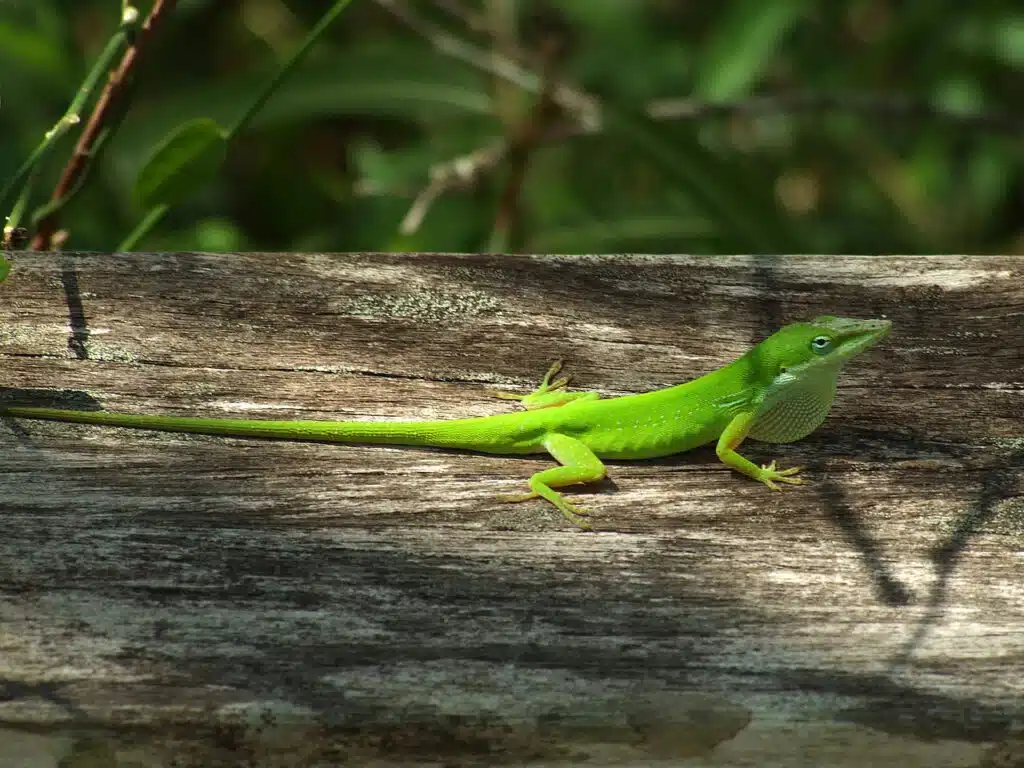
Also known as the American Green Anole (Anolis carolinensis), the lizard has a small to medium size and it’s known for its capacity to change colors, although it isn’t a chameleon.
The lizard changes colors from green to brown.
Considerable physical differences are seen between males and females.
You can identify female Green Anole by a central white stripe along the back.
Males are identified by their larger bodies. More than half the length of the body of the male Green Anole is represented by the tale.
A typical male grows to a varying length between 5 and 8 inches.
The lizard is native to Southern Florida but it’s also among the few species confirmed in other states.
You can see Green Anole in its natural habitat in North and South Carolina.
Texas also has Green Anole populations, as well as the entire region of The Gulf Coast.
You can find Green Anoles in Alabama as well as in Eastern parts of Mexico.
This species is most likely changing its habitat in Northern and Southern Carolina.
It has multiple predators which include snakes.
Cats are among the most important Green Anole predators in urban areas.
2. Green Iguana
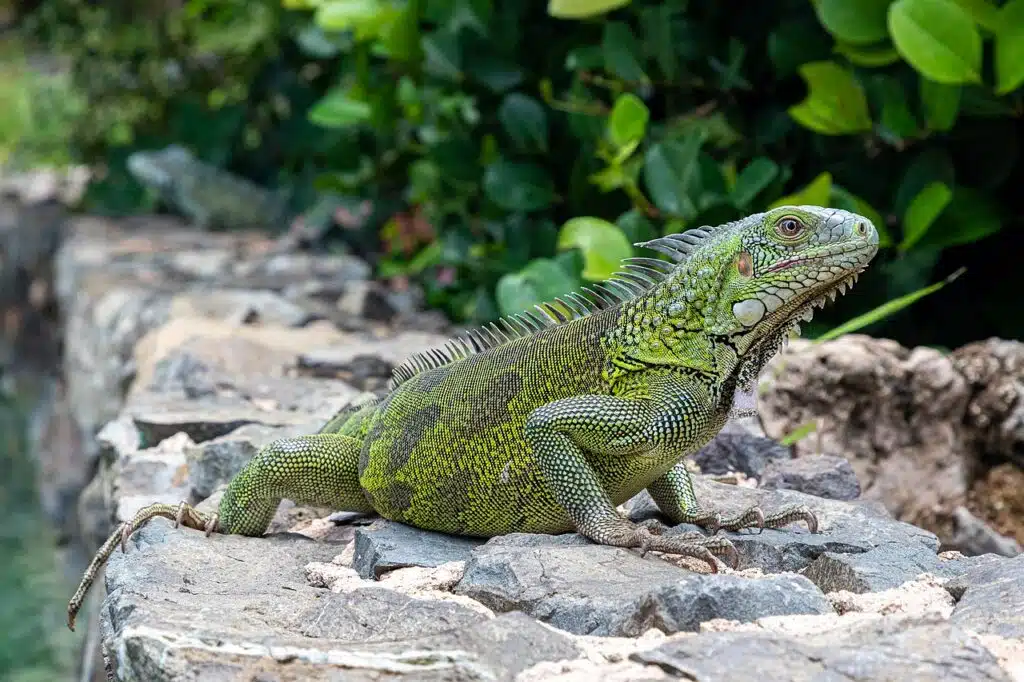
Green Iguanas or Iguanas (Iguana iguana) are a common sight across Northern South America and parts of Central America up to Puerto Rico.
In the US, Green Iguanas have adapted to some climates in Southern Florida as they escaped captivity.
Green Iguanas are also reported in Texas and Hawaii.
This species is one of the larger green lizards in the world with a maximum length of almost 5 feet.
Most Green Iguanas around the world are typically smaller, measuring up to 3 feet.
These colorful species come in all types of bright colors from green to red.
Green Iguanas start to lose their color vividness as they start to get older.
This species is herbivorous. It eats flowers, fruits, and vegetable plants.
This species is highly agile being able to climb up trees and even fall from trees on its feet without being hurt, similarly to cats.
Green Iguanas can also swim and seek shelter in cold weather.
They come down from trees when the weather gets cold to stay on the warmer ground.
This species is also a known burrower in cold weather. It can dig burrows in loose soil or use the leaf litter for shelter.
Not all Green Iguanas are diggers, however.
It turns out those living in Florida are known to seek out the burrows of other species for shelter.
This is the reason the iguana is often found together with turtles.
A diurnal arboreal species, the Green Iguana is easily spotted on trees during the day.
This species is threatened in some parts of the world where people eat it.
3. Gold Dust Day Gecko
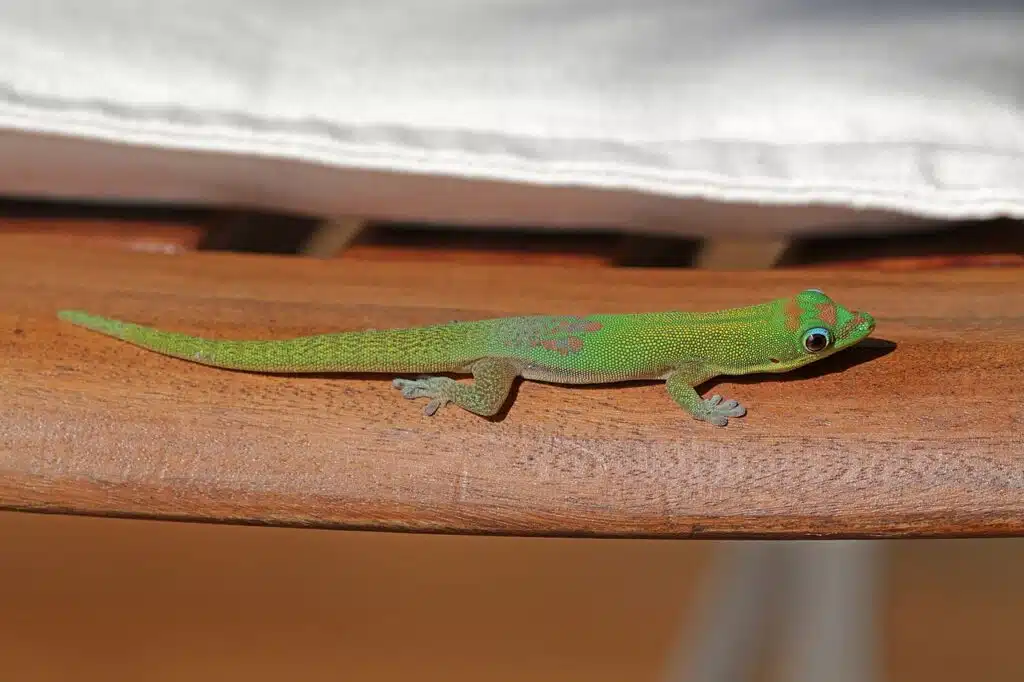
Gold Dust Day Geckos (Phelsuma laticauda) are common as lizard pets. They are native to remote areas of the world such as Madagascar.
This species of lizards is rather small, with the longest individuals measuring just over 5 inches.
Gold Dust Day Geckos feed both on insects and pollen. They can also consume sweet or ripe fruit.
All of these combined foods can make the species live up to 15 years as a pet.
However, Gold Dust Day Geckos aren’t the types of lizards to keep as pets in groups, at least not with multiple males.
The male Gold Dust Day Gecko is very territorial. High aggression levels are seen among the males of the species.
Once mature, this species can start breeding. Gold Dust Day Geckos of Madagascar reach maturity at the age of 10 months or later.
This is the time when they can breed and when the females can lay eggs.
A few eggs are laid by the female in warm weather.
It takes up to a few weeks for Gold Dust Day Geckos’ eggs to hatch.
In captivity, the eggs of the Gold Dust Day Geckos are kept separately.
A high aggression level is specific to the juvenile Gold Dust Day Gecko.
4. Knight Anole
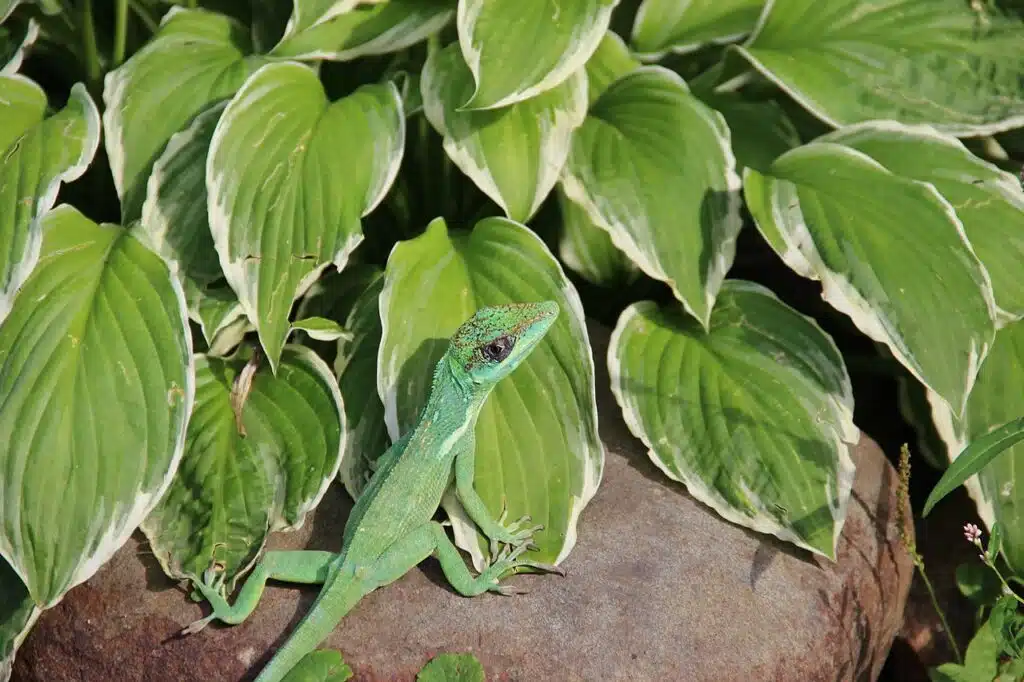
Knight Anoles (Anolis equestris) are native to Cuba. They have been introduced in the US where their population is not well established.
These lizards are seen across Florida but they don’t live as long in the Southeastern state, especially if the weather gets colder than usual.
This species has a green color but it can change its coloring to gray, black, or yellow.
Knight Anoles feed on insects and they are also seen eating sweet fruits when raised in captivity.
These small lizards are highly aggressive, even towards larger predators, not just among members of the species.
Very high aggression levels are seen between male Knight Anoles.
This innate aggression is tempered in Knight Anoles bred in captivity.
Over time, this species can even be handled directly by humans.
However, there’s always a risk of aggression whenever 2 or more male Knight Anole lizards are kept in the same enclosure.
The highest level of aggression is seen in the wild where males fight over territories and scarce foods such as small birds.
These lizards can also fight for other nutritious foods such as small snails.
5. Bark Anole
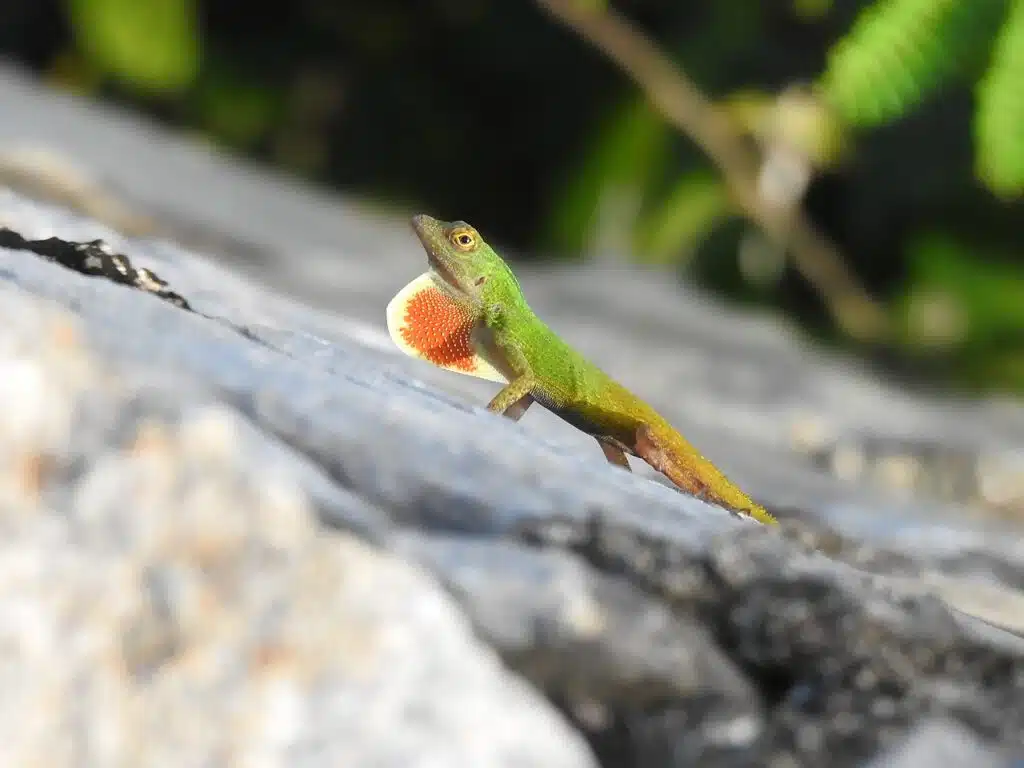
Bark Anoles (Anolis distichus) are a species of lizards native to The Bahamas. This species is known for having a green base color but the lizard can also change colors.
Since it sits on tree bark, this species can take on the coloring of tree bark. Gray base color with black patches is distinguished on the species.
Bark Anoles can sometimes be found in Florida, where the species has settled from other tropical climates.
Bark Anoles remain a small species, even when raised in captivity.
These lizards grow to a size of up to 5 inches.
6. Italian Wall Lizard
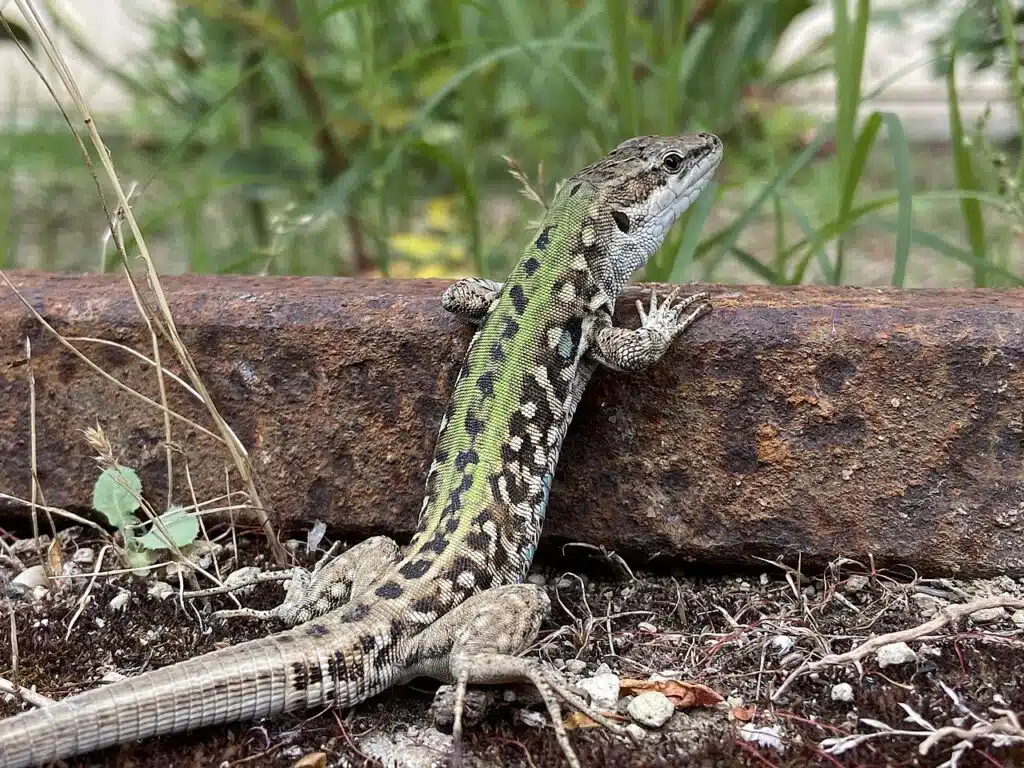
This small to medium-sized green and brown lizard (Podarcis siculus) is native to Italy and neighboring countries.
It has adapted to be one of the most versatile species native to Europe.
Italian Wall Lizards mostly eat arachnids such as beetles. They also eat plants.
Males and females have different diets as the male consumes more food than the female.
This species has plenty of natural predators such as snakes. The lizard has adapted to picking up scents of dangerous snakes to stay away from.
The species is seen across multiple subspecies in The Mediterranean region.
Most of its subspecies have a similar size with a maximum length of 9.8 inches.
7. Jackson’s Chameleon
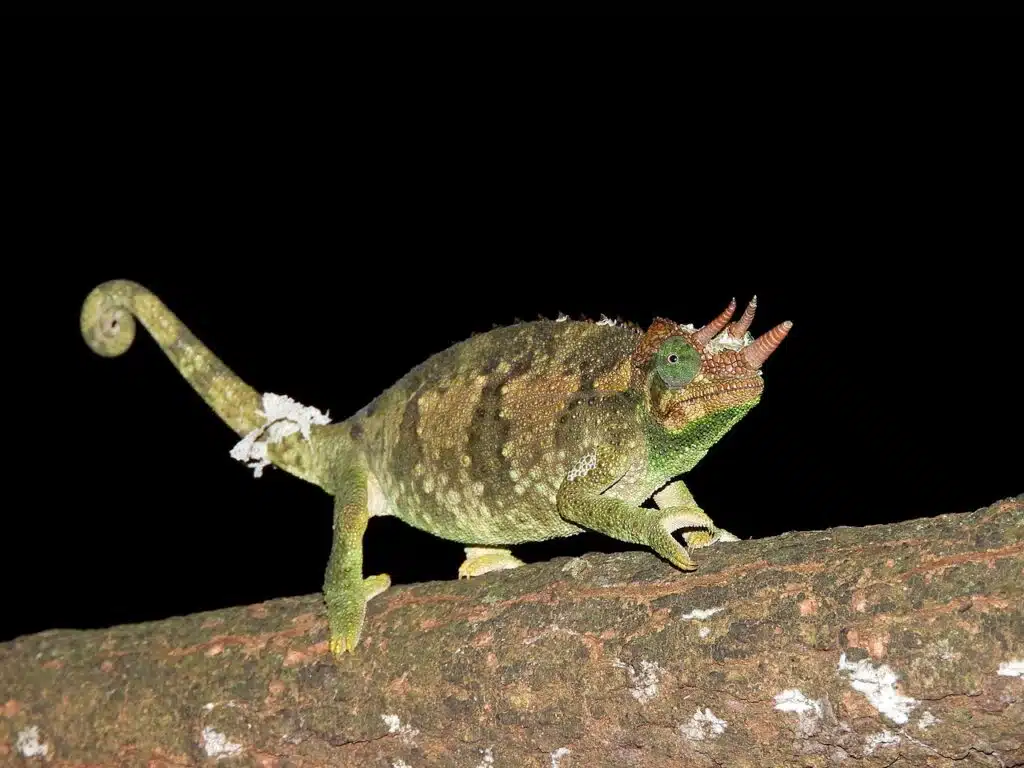
Jackson’s Chameleon (Trioceros jacksonii) is native to Kenya and other Central Eastern regions of Africa.
Subspecies of this genus are found in Florida and Hawaii. The introduction of Jackson’s Chameleon to Hawaii is considered detrimental to the environment due to its feeding behavior.
All types of insects, arthropods, and snails are eaten by this species to a large extent in Hawaii.
Jackson’s Chameleons are some of the largest predators of endangered snails in the state.
Its capacity to change colors is used defensively but also for mating success.
This species stands out with its horns the most. 3 short hours are seen on the top of its head, possibly used in male-to-male aggression and fights.
8. Giant Ameiva
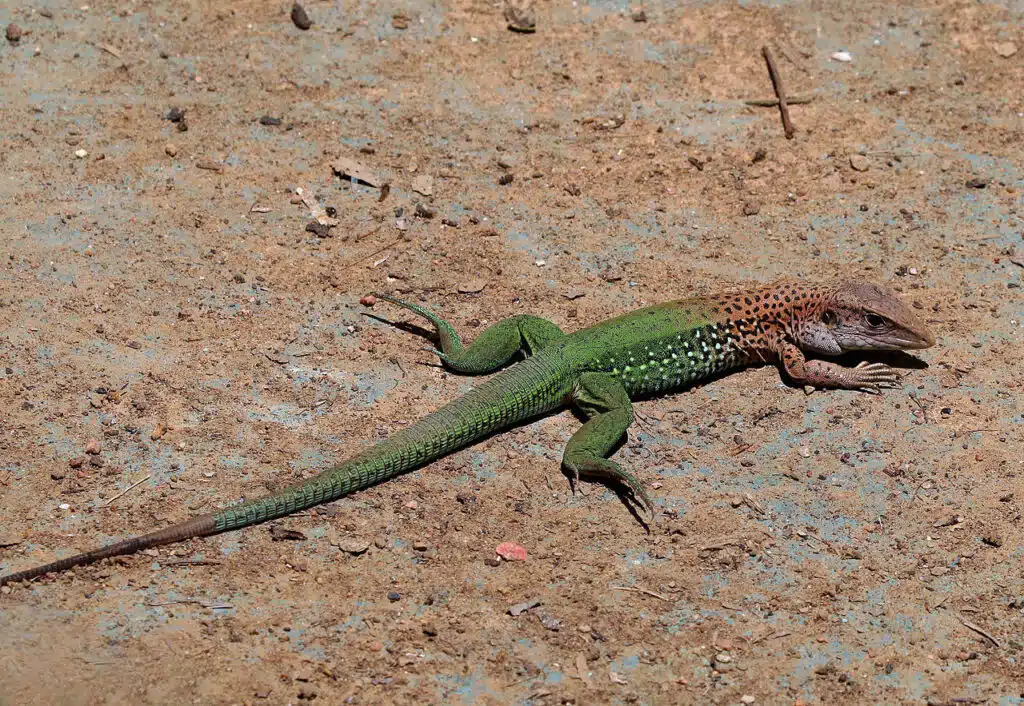
Giant Ameiva lizards (Ameiva ameiva) are native to Central America. The species has been successfully introduced in Florida.
You can identify Giant Ameivas by their green and gray dual-colored body.
The species has more green coloring in the case of males as females as gray-dominant.
You can find Giant Ameiva lizards across woodlands. These lizards aren’t arboreal as they prefer to live under leaf litter.
They eat all types of arthropods found in woodlands.
Common species eaten by these lizards include spiders, grasshoppers, and butterflies.
Underground insects, eggs, and larvae are also eaten by these lizards since they can dig tunnels in loose soils.
9. Madagascar Giant Day Gecko
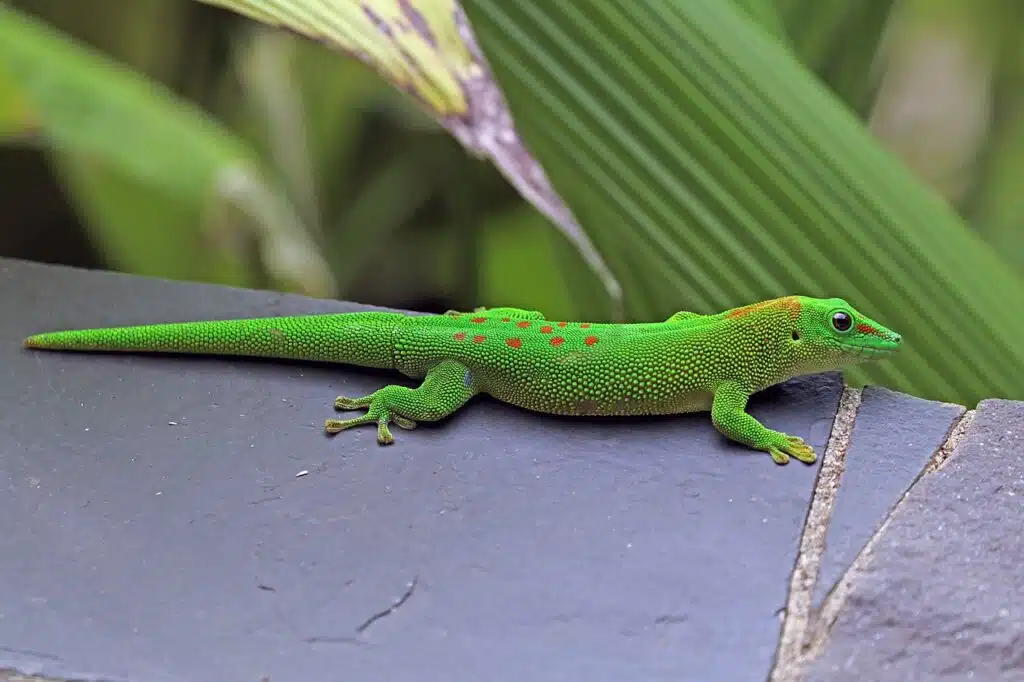
These types of geckos (Phelsuma grandis) are native to Madagascar. They have also been introduced to Florida and other tropical areas around the world.
Known for its base green color, Madagascar Giant Day Geckos are also among the species that eat their young.
Most foods considered by the large gecko are insects and arthropods. Fruits can also be consumed by this species.
More common as a pet gecko, the Madagascar Giant Day Gecko grows to a length between 9 and 11 inches.
As pets, the lizards are appreciated for their vivid green color with red marks. Small red dots are visible on the dorsal side of the species.
10. Rainbow Whiptail
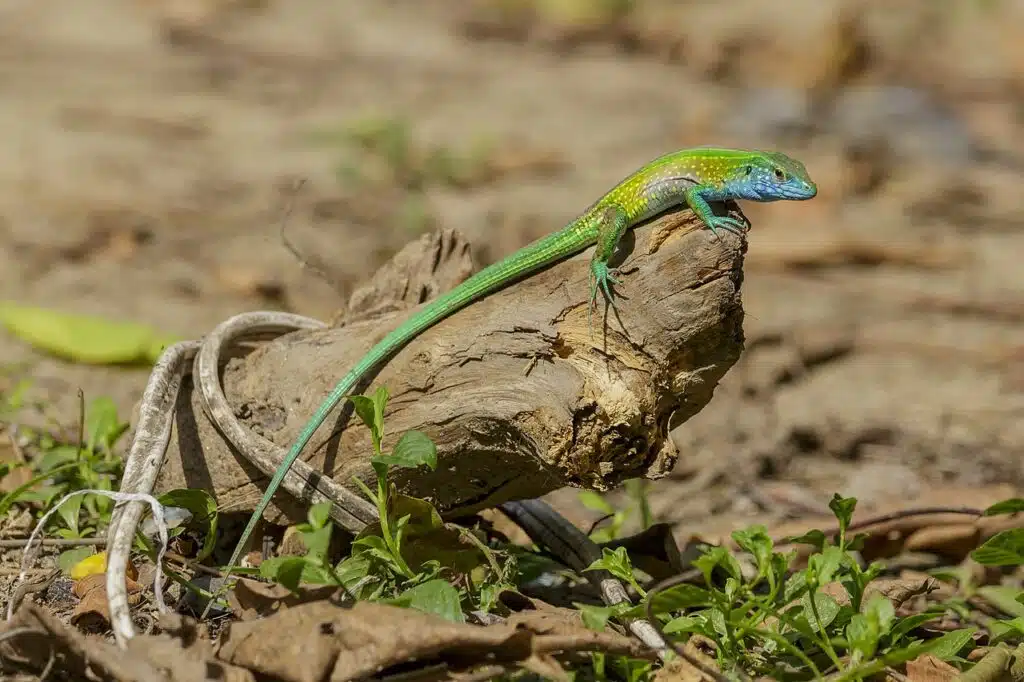
Rainbow Whiptails (Cnemidophorus lemniscatus) grow to a length of up to 12 inches. The species has blue, green, and mustard coloring.
Tiny yellow dots are further distinguishable on the dorsal side of this species.
This species is known to have a mostly green tail.
Rainbow Whiptail has complex mating strategies. These lizards can mate sexually but they can also multiply asexually.
Without fertilization, this lizard can multiply even when living on its own in captivity.
Most Rainbow Whiptail lizards are found in Central and South America.
11. Veiled Chameleon
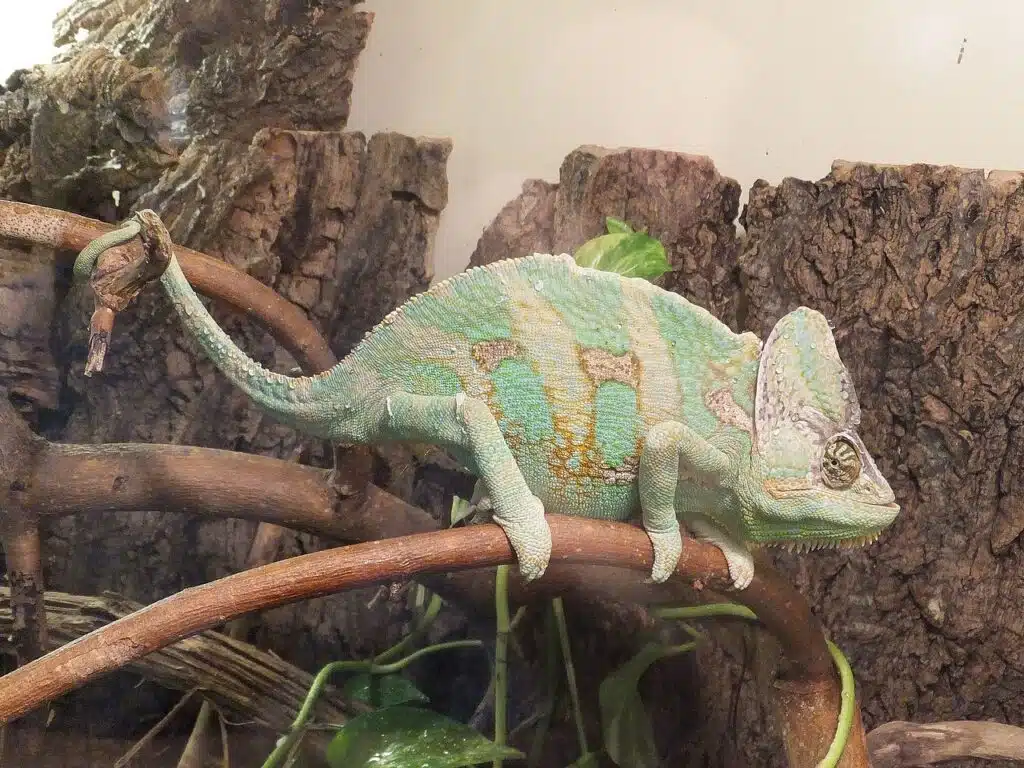
This chameleon (Chamaeleo calyptratus) can quickly change colors. It can adapt from vivid to fading colors as well.
Native to the Arabian Peninsula, the Veiled Chameleon is also known as the Yemen chameleon.
This species grows up to 24 inches, mostly in the case of males.
Females grow to a size of up to 14 inches. While larger, males tend to have slimmer bodies.
This species is a known arboreal lizard. They use camouflage to catch and eat insects.
Lizards of this family also use color-changing abilities during the mating process.
Females are only willing to mate when they change colors, a sign they accept the male’s courtship.
Blue and light blue colors on the female signal the willingness to mate.
High levels of aggression are noted between the males of the species. Mating habits frequently involve fighting between males and females.
12. Hispaniolan Green Anole
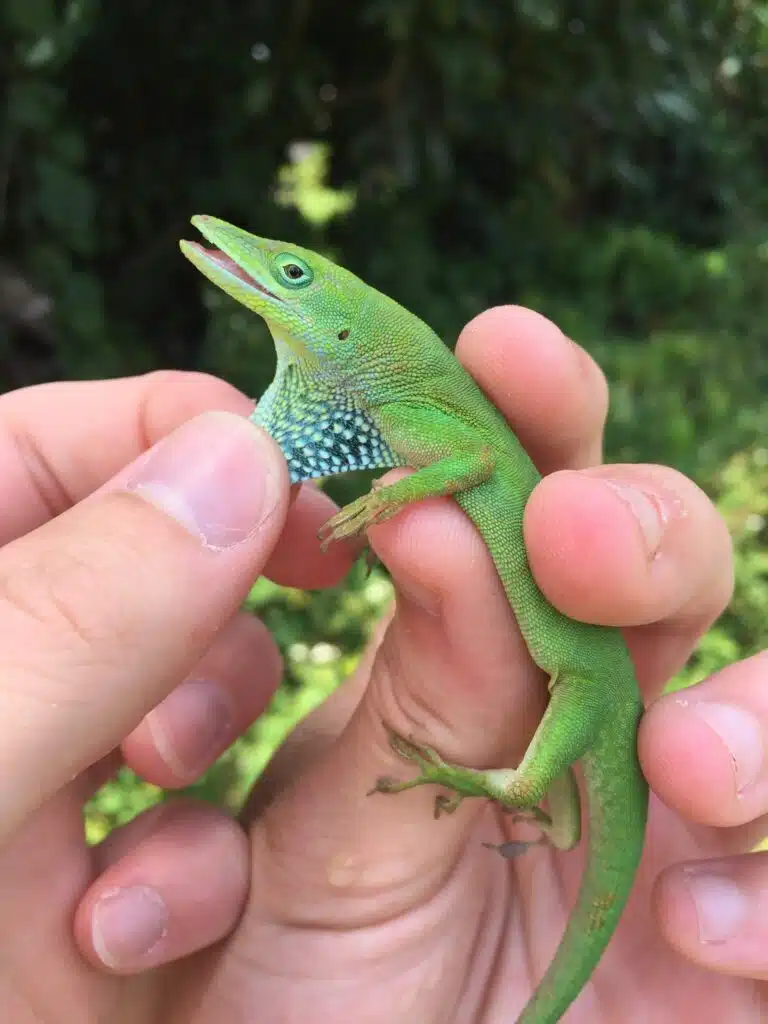
This small species (Anolis chlorocyanus) of Hispaniolan Green Anole is native to Hispaniola Island. It has been introduced to Florida where the lizard is now established.
Green Anoles of this genus have a light green body color and a slightly darker shade of green that characterizes their tail.
The underside is light green, black, and white.
White stripes or bright yellow stripes are seen on its central dorsum.
The species also has yellow overlays across its green legs.
13. Allison’s Anole
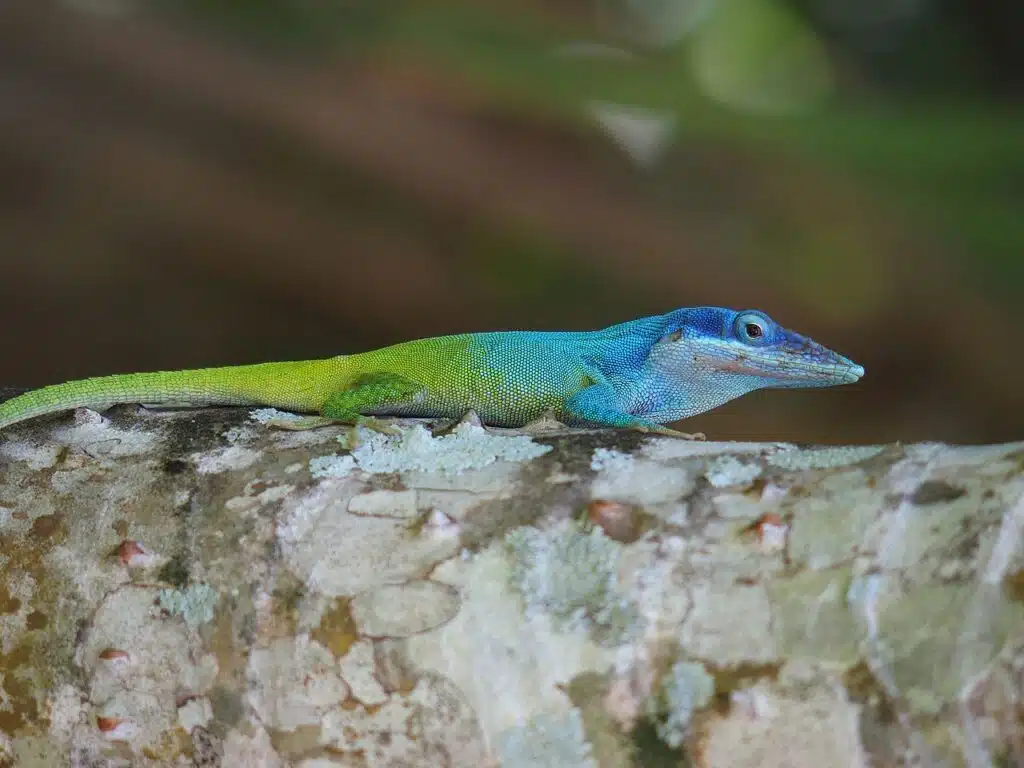
Native to Cuba, Allison’s Anole lizards (Anolis allisoni) are a green species of small size.
This lizard can change its green color to a gray or gray-brown color.
Allison’s Anole lizards have been known to live up to a few feet above the ground, mainly on host trees such as coconut trees.
This species has adapted to remote areas of Florida.
It can be found in the state’s parks and even in residential areas. It doesn’t shy away from climbing man-man buildings.
This species can only be seen in high numbers in Cuba. It has lower numbers all across the neighboring territories where coconut trees are now found in lesser numbers.
14. Panther Chameleon
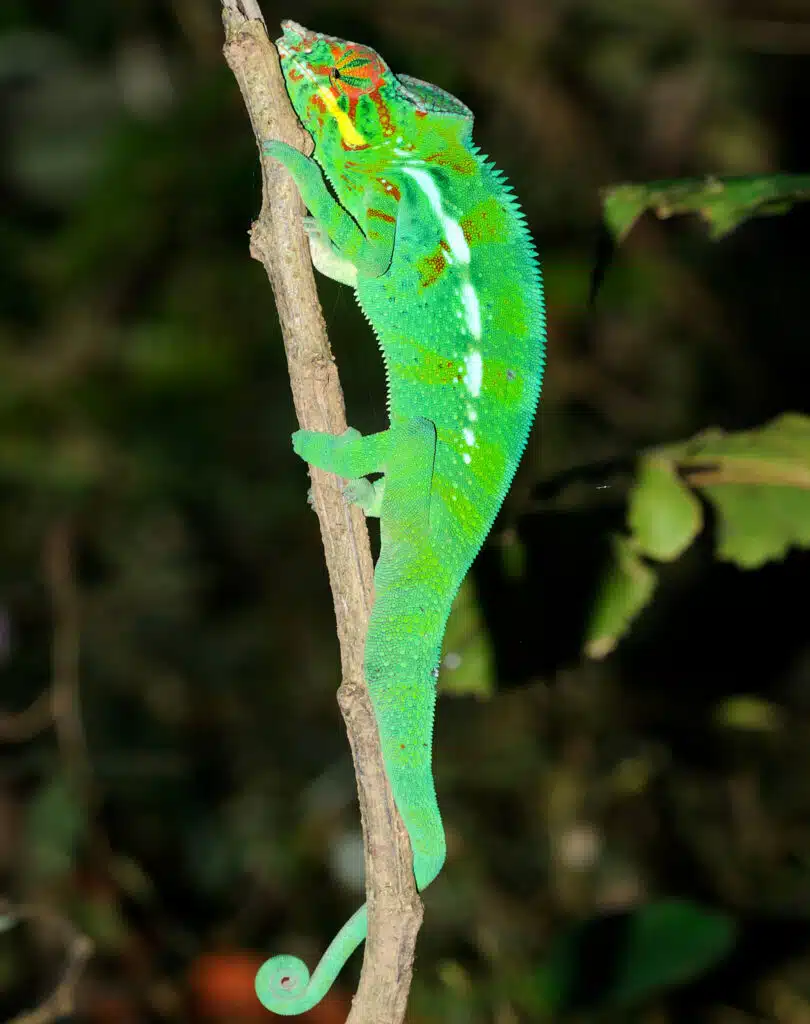
This species (Furcifer pardalis) of chameleons are native to Madagascar. It can be found on the Eastern sides of the island and the Northern parts of the island.
It changes color to red, black, and orange, from a base of green and black.
The color-changing is dictated by the species and even by the mood of the lizard.
This species is one of the lizards with short lives. It lives up to a few years in captivity and up to 1 year in its natural habitat.
Panther Chameleons are also known for being highly aggressive, especially among males.
While they live solitary lives, these chameleons can be territorial when seeing other males.
Color changes and inflating one’s body are signs of territorial aggression.
Females can turn orange and black whenever they’ve mated and when they aren’t ready to mate again.
15. Jamaican Giant Anole
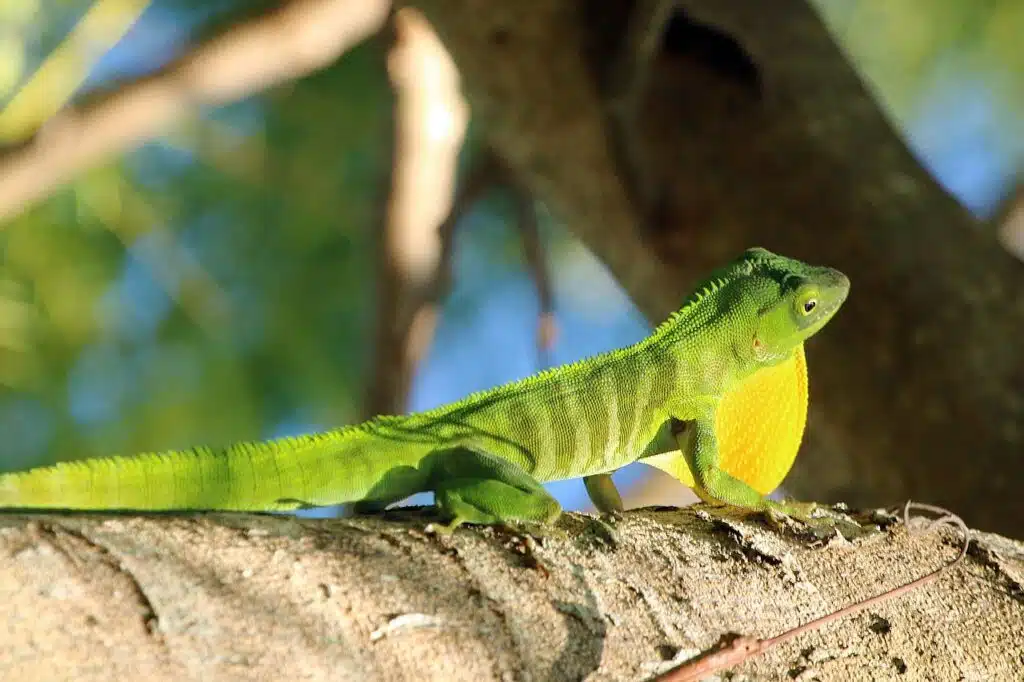
This species (Anolis garmani) of lizards are native to Jamaica. It has varying lengths with the longest Jamaican Giant Anole measuring 14 inches.
Females are typically a bit shorter than males.
Further differences between males and females are seen in the shape and color of the dewlap. Males have large yellow to orange dewlaps while females have green to gray dewlaps.
Jamaican Giant Anoles are mainly seen when raised in captivity.
This species is rare outside its native Jamaica. It’s only reported in Florida outside of Jamaica and occasionally in The Cayman Islands.
16. Oustalet’s Giant Chameleon
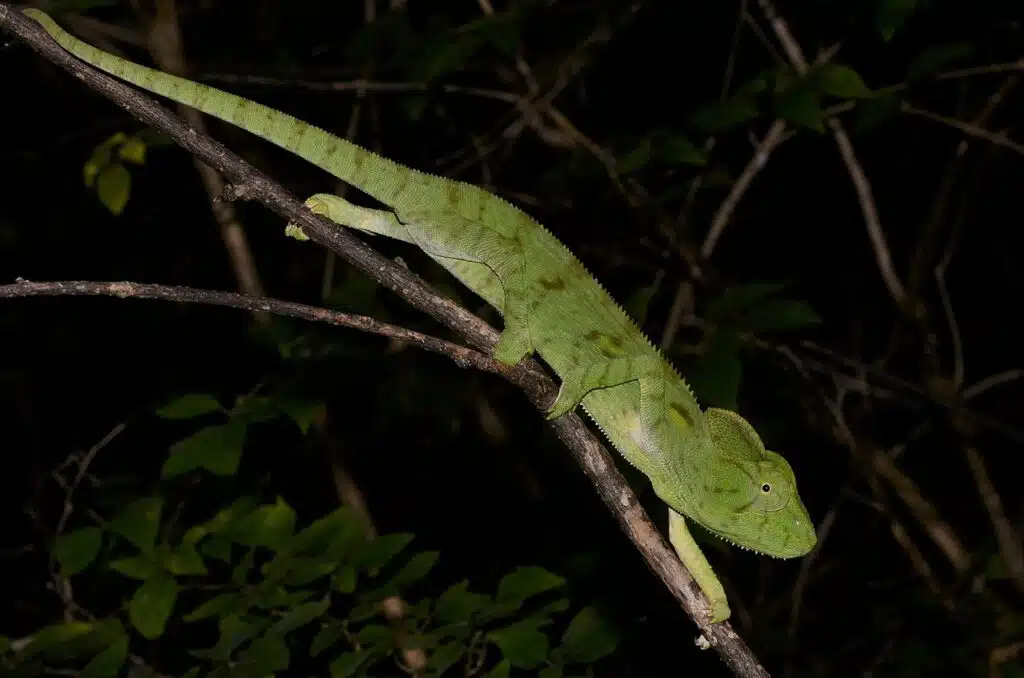
This species (Furcifer oustaleti) of chameleon is native to Madagascar.
Its presence outside the island is sporadic with small populations also being reported across Africa.
Oustalet’s Giant Chameleon is green species with a base green color a length of up to 27 inches and the capacity to change colors.
It lives in woodlands with a preference for open spaces or the edges of the woodlands.
The species changes coloring to gray colors and other earth colors that make it difficult to spot both on trees and the ground.
The species is known to feed on small insects. It can also consume small birds.